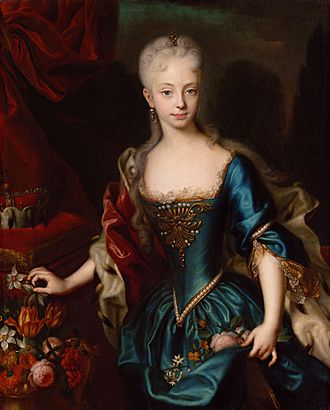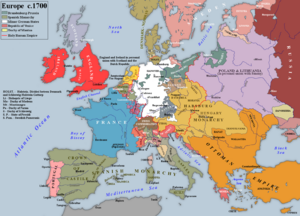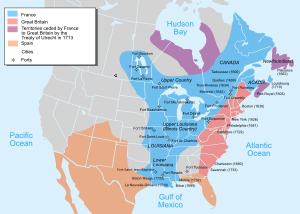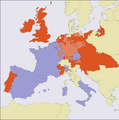Peace of Utrecht facts for kids

First edition of the 1713 Treaty of Utrecht between Great Britain and Spain in Spanish (left) and a later edition in Latin and English.
|
|
| Context |
|
|---|---|
| Signed | 1713–1715 |
| Location | Utrecht, Dutch Republic |
| Signatories | |
| Languages | |
The Peace of Utrecht was a group of important peace treaties. These treaties were signed by countries fighting in the War of the Spanish Succession. They were signed in the Dutch city of Utrecht between April 1713 and February 1715. This war lasted over ten years and involved most of Europe. It started because three different people wanted to be king of Spain.
The main part of the war saw France defending Spain against many other countries. The war was very costly and bloody, and eventually, no side could win completely. The treaties allowed Philip V to remain King of Spain. Philip was the grandson of King Louis XIV of France. In return, Philip had to give up his right to the French throne forever. This was a key promise to make sure France and Spain would never become one country. This helped keep a balance of power in Europe.
These treaties helped end the war. They were signed by countries like Spain, Great Britain, France, Portugal, Savoy, and the Dutch Republic. The treaties showed that France's goal of being the most powerful country in Europe was over. This led to a new system in Europe based on keeping power balanced between countries.
A famous British historian, G. M. Trevelyan, said that this treaty was very important. He believed it ended the danger from the old French monarchy. It also marked a big change for the world: Great Britain became the top country for sea power, trade, and money. Another lasting result was the creation of the Spanish Bourbon dynasty. This family still rules Spain today. The French part of the House of Bourbon lost its throne a long time ago.
Contents
How the Peace of Utrecht Was Negotiated
The War of the Spanish Succession began because Charles II of Spain, the last Habsburg king of Spain, died without any children. After his death in 1700, there was a big argument over who should be the next king. This led to fourteen years of war.
Early in the war, the pro-French Electorate of Bavaria was defeated. This happened at the Battle of Blenheim in 1704. Bavaria then had to sign a treaty and was occupied by Austrian forces.
In 1710, King Louis XIV of France agreed to start peace talks. These talks began in a place called Geertruidenberg.
Great Britain and France reached an agreement in October 1711. These were early peace terms signed in London. They quietly agreed to divide Spain's lands in Europe. After this, the main peace meeting, called the Congress of Utrecht, started on January 29, 1712. Great Britain sent its representatives, including John Robinson and Thomas Wentworth.
The Dutch Republic reluctantly joined the talks. Emperor Charles VI of the Holy Roman Empire only sent his representatives after being promised the early terms were not final. Spain did not send anyone at first because Philip was not yet recognized as its king. The Duke of Savoy and the Kingdom of Portugal did send representatives.
One of the first big issues was how to guarantee that the crowns of France and Spain would stay separate. Not much progress was made until July 10, 1712. On that day, Philip signed a document giving up his claim to the French throne.
Negotiations sped up after Great Britain, France, and Spain agreed to stop fighting in Spain on August 19 in Paris. The first treaty signed at Utrecht was a truce between France and Portugal on November 7. A truce between France and Savoy followed on March 14, 1714. On the same day, Spain, Great Britain, France, and the Holy Roman Empire agreed to remove troops from Catalonia and stop fighting in Italy.
The main peace treaties were signed on April 11, 1713. These were five separate treaties between France and Great Britain, the Netherlands, Savoy, Prussia, and Portugal. Spain, under Philip V, signed its own peace treaties with Savoy and Great Britain at Utrecht on July 13. The talks at Utrecht continued into the next year. The peace treaty between Spain and the Netherlands was signed on June 26, 1714. The one between Spain and Portugal was signed on February 6, 1715.
Other agreements also came from the Utrecht congress. France signed trade and shipping treaties with Great Britain and the Netherlands on April 11, 1713. Great Britain signed a similar treaty with Spain on December 9, 1713.
Key Agreements in the Treaties

The Peace of Utrecht confirmed that the Bourbon candidate, Philip V of Spain, would remain king of Spain. In return, Philip gave up his right to the French throne. This applied to his children and future family members too. French Bourbons also gave up their claims to the Spanish throne. This was very important because several deaths between 1712 and 1714 meant that the five-year-old Louis XV was the only heir to the French throne.
Great Britain gained the most from these treaties. Utrecht marked the time when Britain became the leading trading power in Europe. In one important part of the treaty, Spain gave Great Britain control of the important ports of Gibraltar and Minorca.
A big win for the British was getting the Asiento de Negros. This was a special contract that gave Britain the right to supply slaves to Spain's colonies in the Americas. The Spanish Empire usually did not transport slaves itself. Instead, it hired foreign traders to do this. Before, France had this contract, allowing French slave traders to bring 5,000 slaves to the Spanish Empire each year. After Britain got the Asiento, the South Sea Company was set up to manage this trade. This helped Britain try to reduce its national debt by increasing trade with Spain.
British negotiators also demanded that France destroy the forts and harbor of Dunkirk. This was because Dunkirk was a main base for French privateers (private ships allowed to attack enemy ships). These privateers could easily reach the North Sea and avoid British patrols. However, this rule was hard to enforce later on.
Under another part of the treaty, Spain agreed to a British request to protect Catalan historical rights. This was in exchange for Catalonia's support for the Allies during the war. Spanish lands in Italy and Flanders were divided. Savoy received Sicily and parts of the Duchy of Milan. The former Spanish Netherlands, the Kingdom of Naples, Sardinia, and most of the Duchy of Milan went to Emperor Charles VI.
In South America, Spain returned Colónia do Sacramento (in modern Uruguay) to Portugal. Spain also recognized Portugal's control over lands between the Amazon and Oyapock rivers, which are now in Brazil.
In North America, France recognized British control over the Iroquois people. France also gave up Nova Scotia and its claims to Newfoundland and lands in Rupert's Land. The French part of Saint Kitts in the West Indies was also given entirely to Britain. France kept its other lands in North America from before the war. This included Cape Breton Island, where it built the Fortress of Louisbourg. This was the most expensive military base in North America at the time.
The successful French military campaign in the Rhineland in 1713 finally made Charles VI sign the 1714 treaties of Rastatt and Baden. However, terms with Spain were not fully agreed until the 1720 Treaty of The Hague.
Reactions to the Treaties

Some people in Britain, especially the Whigs, thought the treaty's land agreements did not go far enough. They felt France should have given up more, especially since France had offered peace earlier in 1706 and 1709. The Whigs were strong supporters of being against France. They saw themselves as following the policies of William III and the Duke of Marlborough. Even though they were a minority in Parliament, the Whigs kept pushing against the peace. They even called the treaty a "sellout" because Philip V was allowed to stay on the Spanish throne.
However, in the Parliament of 1710, the Tories gained control of the House of Commons. They wanted Great Britain to stop fighting in the European war. Queen Anne and her advisors also agreed it was time for peace.
The government, led by Robert Harley and Viscount Bolingbroke, was more flexible in the negotiations. The Whigs called them "pro-French." Harley and Bolingbroke convinced Queen Anne to create twelve new "Tory peers." This was to make sure the treaty would be approved in the House of Lords. Those against the treaty tried to get support with the slogan No Peace Without Spain.
The Spanish Netherlands was very important to the Dutch Republic. However, the Dutch had little influence on the negotiations, even though the talks were held in their country. The French negotiator even made a sarcastic remark to the Dutch: de vous, chez vous, sans vous. This meant the negotiations would be "about you, around you, without you." This showed how little power the Dutch had.
Also, Bolingbroke secretly told the British commander to pull his troops away from the Allied forces. This happened before the Battle of Denain. The French were told, but not the other Allies. This secret separate peace with France made the Allies' objections useless. Still, the Dutch did gain shared control in the Austrian Netherlands through the Austro-Dutch Barrier Treaty of 1715.
What Happened After the Treaties
The Treaty of Utrecht stated that "because of the great danger which threatened the liberty and safety of all Europe, from the too close conjunction of the kingdoms of Spain and France, ... one and the same person should never become King of both kingdoms". This rule was very important. Some historians believe it was a key moment in developing the idea of the modern nation-state. It also helped establish the concept of a balance of power between countries.
The idea of a "balance of power" was first mentioned in 1701. It became well-known in Britain thanks to writer Daniel Defoe in 1709. This idea was written into the treaties. It appeared again after Napoleon's defeat in 1815 with the Concert of Europe. This idea guided European politics throughout the 19th century.
For the countries that signed, Britain became the strongest naval power. It gained trade access to Spain and America. It also took control of Menorca and Gibraltar. Britain still controls Gibraltar today. France accepted the Protestant succession on the British throne. This made sure there was a smooth change when Queen Anne died in August 1714. France also stopped supporting the Stuarts, a rival royal family, under the 1716 Anglo-French Treaty. The war left all countries with huge government debts. However, only Great Britain managed to pay off its debt successfully.

Spain kept most of its empire and recovered surprisingly quickly. An attempt to take back Naples and Sicily in 1718 was stopped by British naval power. However, a second attempt in 1734 was successful. The Nueva Planta decrees of 1707, 1715, and 1716 ended regional political systems in Aragon, Valencia, Majorca, and Catalonia. Catalonia and Aragon kept some of these rights until 1767.
Despite not winning in Spain, Austria secured its position in Italy and Hungary. This allowed it to expand into parts of Southeast Europe that were previously controlled by the Ottoman Empire. Even after paying for the Dutch Barrier, increased taxes from the Austrian Netherlands helped Austria improve its military. However, these gains were lessened by other issues. One major issue was the problem with the Pragmatic Sanction of 1713. This was Charles VI's plan to let his daughter Maria Theresa inherit his lands, even though it meant disinheriting his nieces.
Efforts to secure Maria Theresa's succession led Austria into wars that were not strategically important. Much of the fighting in the 1733–1735 War of the Polish Succession happened in Austria's coastal areas in Italy. Austria had relied on naval support from the Dutch, but the Dutch navy was much weaker now. Britain prevented the loss of Sicily and Naples in 1718 but refused to do so again in 1734. This dispute continued to weaken Habsburg control over the Holy Roman Empire. Bavaria, Hanover, Prussia, and Saxony acted more and more like independent powers. In 1742, Charles of Bavaria became the first non-Habsburg Emperor in over 300 years.
The Dutch Republic ended the war almost bankrupt. The damage to the Dutch merchant navy permanently hurt their trade and political power. Britain took over as the leading European trading power. However, gaining the Barrier Fortresses became an important part of Dutch foreign policy. It also expanded their area of influence. Although people at the time thought the barrier was good, it later proved to be not very effective during the War of Austrian Succession. Still, the Dutch had successfully defended their positions in the Southern Netherlands. Their troops were key in the alliance that stopped French expansion in Europe until new wars began in 1792.
The final agreement at Utrecht was much better for France than the Allies' offer in 1709. However, France gained little that it hadn't already achieved through diplomacy by February 1701. France remained a great power. But concerns about its military and economic decline compared to Britain were a hidden reason for the War of the Austrian Succession in 1740.
Images for kids
-
Signature of the Treaty of Utrecht between Portugal and Spain, on 6 February 1715. From left to right: The Duke of Osuna, in red coat, Luís da Cunha, in black coat, The Secretaries, in blue and yellow coats and the Count of Tarouca, crouched, in brown coat.
See also
 In Spanish: Tratado de Utrecht para niños
In Spanish: Tratado de Utrecht para niños
- Disputed status of Gibraltar
- French Shore
- Herman Moll
- Utrecht Te Deum and Jubilate, composition by Handel





